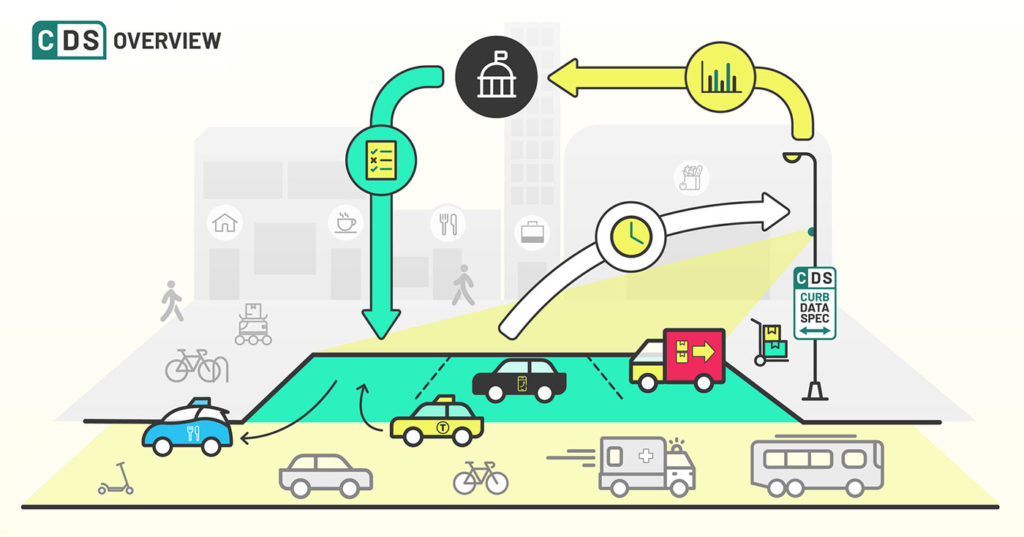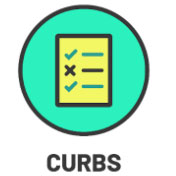AN OFFICIAL RELEASE
Over the past year, stakeholders from across the transportation ecosystem participated in the development of the Curb Data Specification (CDS) — a new digital tool that helps cities and companies pilot and scale dynamic curb zones. Now an official release, CDS 1.0 was approved by OMF’s Board of Directors this week.
“Today, curb space is one of the most high-demand public assets, but cities need efficient and effective tools to help them make the most of this valuable real estate,” said LADOT General Manager Seleta Reynolds. “The Curb Data Specification is a critical tool that gives cities the data they need to make strategic decisions, advance policies, and respond to changing market dynamics with the same flexibility as their private sector partners. Already, dozens of cities and companies are making use of this open source tool to advance dynamic curb management pilots and develop innovative solutions to our communities’ most pressing transportation needs.”
ABOUT THE CURB DATA SPECIFICATION
The Curb Data Specification (CDS) is a digital tool that helps cities and companies pilot and scale dynamic curb zones that optimize commercial loading activities. This tool provides a mechanism for cities to express curb regulations, measure activity, and develop policies that create more accessible, useful curbs.

At its core, CDS is a set of APIs which allow cities to digitally represent their curb space and communicate with curb users in different ways:

Curbs API: A standard way for cities to digitally publish curb locations and regulations, which can be shared with the public and with companies using curb space.

Events API: A standard way to transmit real-time and historic commercial events happening at the curb to cities. Event data can be derived
from company data feeds, sensors, check-ins, and other city data sources.

Metrics API: Track curb usage session details and define common calculation methodologies to measure historic dwell time, occupancy, usage and other aggregated statistics.
HOW CITIES AND COMPANIES ARE USING CDS
CDS’ flexibility means it can be used in many scenarios. Some specific CDS use cases include:
Omaha, NE
The City of Omaha is planning to utilize CDS to reduce congestion and decrease the risk of potential hazards relating to delivery of goods and services in their Central Business District. The City is working with their technology provider to create a Curbs API hosted within the Park Omaha Website. This will allow for easier integration with other software providers and to actively track curbside usage.
San Francisco, CA
In San Francisco, the San Francisco Municipal Transportation Agency (SFMTA) has initiated work on a Digital Curb Program. The Digital Curb Program is a combination of data collection, data maintenance, mapping and workflow upgrades that will store all curb assets regulations into a single data model, and provide SFMTA staff and the public with a complete picture of every asset and regulation on the curb. As part of its Digital Curb program, SFMTA will provide curb regulation data via a Curbs API, which will be published using the OMF CDS format.
Seattle, WA
The City of Seattle Department of Transportation is currently working to develop and publicly publish the location of its loading zones in the CDS format. One of Seattle’s curbside management goals is to make its curb regulation data more accessible to users that are looking to cut carbon emissions and maximize efficiencies of the curb. Providing this information in the new CDS standard will help to achieve that goal. To learn more about Seattle’s role in shaping CDS, please visit the SDOT blog here.
These are just select examples from the more than two dozen cities and companies using or planning to use CDS.
RESOURCES
Whether you’re ready to implement CDS 1.0 or just looking for more information, the OMF has a variety of resources available to help get you started:
- Website: CDS overview with links to key resources
- Slide Deck: OMF & CDS overview in presentation format, with links to key resources
- One-Pager: OMF & CDS overview, ready to print and share
- GitHub Repository: Find the CDS 1.0 code release and review related discussion and contributions
- Policy Language: Sample policy language and guidance for cities that wish to write CDS into their operating policy, permits, tenders, or RFPs
- Privacy Guidance: Guidance related to the collection and handling of potentially sensitive information related to CDS
- Pilot Program Guide: Guidance on how to use CDS in curb pilot programs
WHAT’S NEXT FOR CDS
CDS was developed as a free and open standard by OMF’s Curb Management Working Group. Formed to develop data specifications for curb space in the OMF’s open-source model, the group is led by a steering committee of individuals representing public and private sector organizations. More than 160+ individuals from 70+ public agencies, curb users, and technology companies have participated in the development of CDS.
Community input and engagement will continue to shape the specification. The Curb Management Working Group is open to both OMF members and individual contributors. To participate in the development of CDS:
- Sign up for the Curb Working Group mailing list to get meeting invites, agendas, and important updates
- Join bi-weekly meetings (Tuesdays, 12pm ET) to discuss issues and hear from other contributors
- Follow progress and chime in on our CDS GitHub repository




